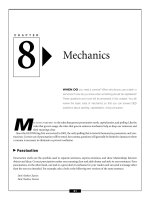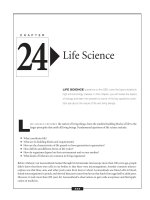About the GED Science Exam
Bạn đang xem bản rút gọn của tài liệu. Xem và tải ngay bản đầy đủ của tài liệu tại đây (148.43 KB, 14 trang )
What to Expect on the GED Science Test
The science portion of the GED consists of 50 multiple-choice questions designed to evaluate your understand-
ing of general science concepts. Each question is followed by five answer choices labeled a through e.You will be
instructed to select the best answers to the question. There is no penalty for guessing. You will have 80 minutes
(one hour and 20 minutes) to answer the questions on this part of the exam. There will be some question sets—
i.e., more than one question will be asked about a particular graphic or passage.
Types of Questions
On the test, you will encounter 25 conceptual understanding and 25 problem-solving questions.
A question that tests your conceptual understanding requires you to show your understanding of the material
presented as a part of the question. In this type of question, you could be asked to:
■
read a graphic
■
summarize the results of an experiment
■
rephrase a fact or an idea described in a passage
■
find supporting detail in a passage
■
make a generalization about information presented in the question
■
understand cause and effect
CHAPTER
About the GED
Science Exam
TO PREPARE effectively for the GED Science Exam, you need to
know exactly what the test is like. This chapter explains the structure
of the exam, including the types of questions you will be asked and the
topics that will be tested.
20
209
Problem-solving questions will ask you to apply your
understanding of information presented as part of the
question. Questions of this type could require you to:
■
interpret results
■
draw conclusions based on results
■
analyze experimental flaws or logical fallacies in
arguments
■
make a prediction based on information pro-
vided in the question
■
select the best procedure or method to accom-
plish a scientific goal
■
select a diagram that best illustrates a principle
■
apply scientific knowledge to everyday life
■
use the work of renowned scientists to explain
everyday global issues
Some questions will require you to draw on knowl-
edge you have acquired through your daily life and prior
schooling. In other questions, all the necessary informa-
tion will be included in the passage or graphic provided
as part of the question. In either case, reviewing basic sci-
ence concepts presented in the following chapters and
answering as many practice questions as you can will
improve your performance.
About half the problems on the GED Science Exam
will require you to understand, interpret, or apply infor-
mation presented in graphical form. Graphical informa-
tion includes diagrams, charts, and graphs. Graphics are
a concise and organized way of presenting information.
Once you realize that all graphics have some common
basic elements, it will not matter whether their informa-
tion presented is in the area of biology, chemistry,
physics, or Earth science.
D
IAGRAMS
Diagrams can be used to show a sequence of events, a
chemical or biological process, the setup of a science
experiment, a phenomenon, the relationship between
different events or species, and so forth. Here are some
examples that you can look up in your science textbooks:
■
diagram of an electrochemical cell (physical
science)—process
■
diagram of the phases of cell division (life
science)—sequence of events
■
pedigree diagram for color blindness (life
science)—relationship between events
■
diagrams showing the oxygen and nitrogen cycle
(Earth and space science)—process
■
diagram showing the repulsion of like charges
(physical science)—phenomenon
■
diagram illustrating the titration technique
(chemistry)—setup of an experiment
When you see a diagram, first ask yourself what its
purpose is: What is it trying to illustrate? Then look at
the different labeled parts of the diagram. What is their
function? How are they interrelated?
C
HARTS
All charts are composed of rows (horizontal) and
columns (vertical). Entries in a single row of a table usu-
ally have something in common, and so do entries in a
single column. Two common questions about charts
involve reading an entry and finding a trend. Is there a
change? Do the numbers increase? Decrease?
G
RAPHS
The most common types of graphs are scatter plots, bar
graphs, and pie graphs. Whenever a variable depends
continuously on another variable, this dependence can
be visually represented in a scatter plot. An example of
data that can be represented on a scatter plot is popula-
tion growth as a function of time. A scatter plot consists
of the horizontal (x) axis, the vertical (y) axis, and col-
lected data points for variable y, measured at variable x.
A graph often contains a legend, especially if there is
more then one data set or more than one variable. A leg-
end is a key for interpreting the graph. It lists the symbols
used to label a particular data set.
Bar graphs are similar to scatter plots. Both have a
variable y plotted against a variable x. However, in bar
graphs, data is represented by bars, rather than by points.
Bar graphs are often used to indicate an amount or level,
as opposed to a continuous change. You may have seen
bar graphs on your family’s utility bill. Utility companies
often plot the amount of energy used by an average con-
sumer during different months of the year.
Pie graphs are used to show what percent of a total is
taken up by different components of that whole. For
example, a pie chart could be used to show the percent of
science students who major in chemistry, physics, biol-
ogy, geology, and astronomy.
–
ABOUT THE GED SCIENCE EXAM
–
210
Test Topics
The topics covered on the GED Science Exam are:
■
physical science—35% of the questions
■
life science—45% of the questions
■
Earth and space science—20% of the questions
On the GED, physical science includes high school
physics and chemistry and covers the structure of
atoms, the properties of matter, chemical reactions, con-
servation of mass and energy, increase in disorder, the
laws of motion, forces, and the interactions of energy
and matter.
Life science deals with subjects covered in high school
biology classes, including cell structure, heredity, bio-
logical evolution, behavior, and interdependence of
organisms.
Earth and space science GED questions will test your
knowledge of the Earth and solar system, the geochem-
ical cycles, the origin and evolution of the Earth, and the
universe.
Recent Changes in the GED
In accordance with Education Standards set forth by the
National Academy of Sciences, the GED Science Test has
been modified to include more interdisciplinary ques-
tions. These questions also fall into one of the three
major categories (physical science, life science, and Earth
and space science) but focus on themes common to all
sciences. Common themes include the scientific method,
the organization of knowledge, applications in technol-
ogy and everyday situations, and the development of sci-
entific ideas through history. Since 50% of the GED
Science questions will be interdisciplinary, a chapter will
cover each of the following themes:
■
unifying concepts and processes
■
science as inquiry
■
science and technology
■
science and personal and social perspectives
■
history and nature of science
Unifying concepts and processes in science include
the organization of scientific knowledge, development of
scientific models based on experimental evidence, equi-
librium, change, conservation, measurement, and rela-
tionship between form and function. Approximately two
questions on the GED Science Exam will fall into this
category.
Science as inquiry questions can require you to sum-
marize and interpret experimental results, select relevant
information, understand and apply the scientific
method, make a prediction or draw a conclusion based
on given facts, and evaluate the source of experimental
flaws and error. There will be about seven questions of
this type on the GED.
Science and technology questions require you to
understand the function of an instrument, instructions
for operating an instrument, technological processes, the
elements of technological design, how technology uses
scientific knowledge to improve products and processes,
and the impact of technology on science, human life, and
environment. About three questions of this type will
appear on the test.
Science and personal and social perspectives ques-
tions include questions on human health (nutrition,
exercise, disease prevention, genetics), climate, pollution,
population growth, natural resources, social impact of
natural disasters, human-induced environmental haz-
ards, public policy, application of scientific knowledge to
everyday situations, and application of scientific knowl-
edge to explain global phenomena. These questions are
quite common. You can expect to see about nine of them
on the GED.
History and nature of science questions could
include a passage on the development of an idea or the-
ory through time, or the work of an important scientist.
You could also expect to see general questions about the
development of science as a field and its principles. You
will probably see about three questions of this type on
the GED.
The chart on the next page summarizes the approxi-
mate breakdown of question types and subjects covered
in the questions on the GED Science Exam.
–
ABOUT THE GED SCIENCE EXAM
–
211
GED SCIENCE EXAM
50 QUESTIONS, 80 MINUTES
Type: 25 conceptual understanding questions, 25 problem-solving questions
Format: 25 short paragraph questions, 25 questions based on a passage or graphic
Subject: 45% life science questions, 35% physical science questions, 20% Earth and space science questions
Content: 25 fundamental science (life, physical, Earth/space) questions, 25 interdisciplinary questions
–
ABOUT THE GED SCIENCE EXAM
–
212
In addition to the interdisciplinary questions, other
recent changes to the GED Science Exam include:
■
increased focus on environmental and health top-
ics (recycling, heredity, prevention of disease, pol-
lution, and climate)
■
increased focus on science as found in daily life
■
increased number of single-item questions
■
decreased number of questions based on the
same passage/graphic
Now that you have a better idea of the kind of ques-
tions that may appear on the GED Science Exam, you
can start reviewing the basic science concepts described
in the next chapters.
W
HETHER THEY ARE
chemists, biologists, physicists, or geologists, all scientists seek to organ-
ize the knowledge and observations they collect. They look for evidence and develop models
to provide explanations for their observations. Scientists depend heavily on measurement and
developed devices and instruments for measuring different properties of matter and energy. Scientists also use
units to make the quantities they measure understandable to other scientists. Questions that come up in every
science are:
■
What causes change?
■
What causes stability?
■
How does something evolve?
■
How does something reach equilibrium?
■
How is form related to function?
Systems, Order, and Organization
What happens when an Internet search produces too many results? Clearly, having some results is better than hav-
ing none, but having too many can make it difficult to find the necessary information quickly. If scientists didn’t
systematically organize and order information, looking for or finding a piece of data or making a comparison
CHAPTER
Unifying
Concepts and
Processes
THIS CHAPTER will review some of the unifying concepts and
processes in science. You will learn the questions and themes that are
common to each of the scientific disciplines and how scientists seek
to answer those questions.
21
213









